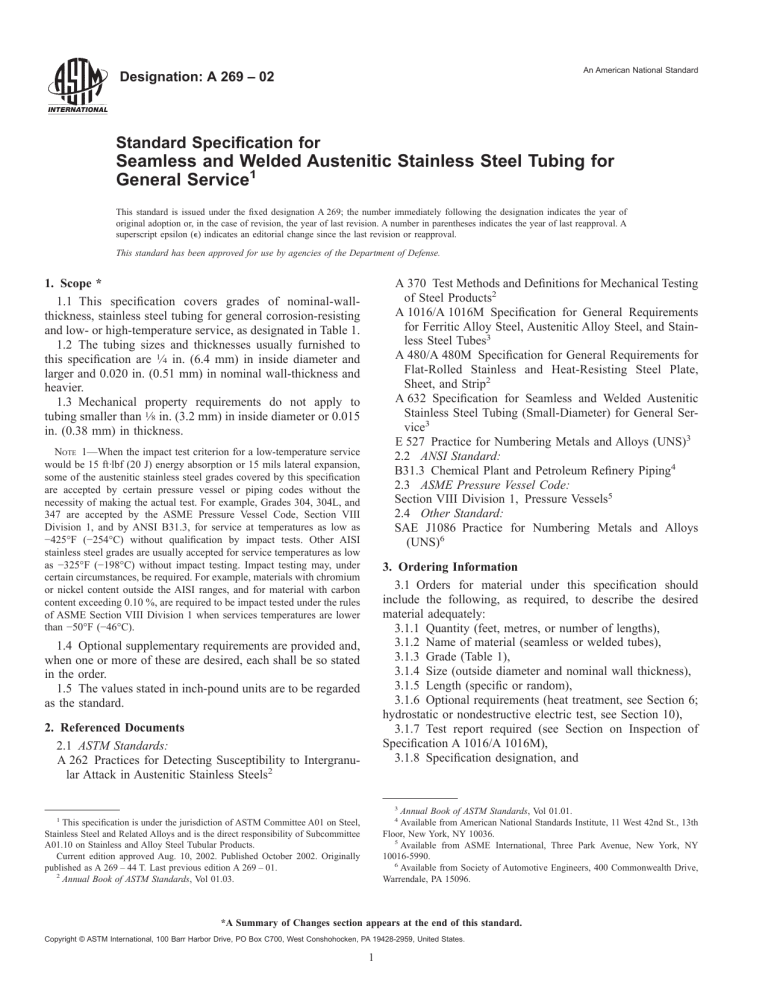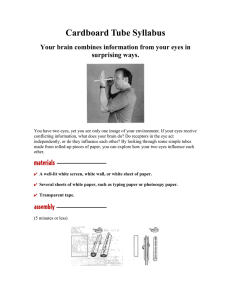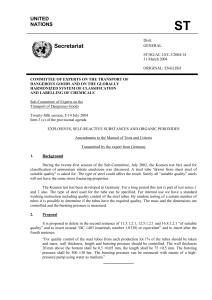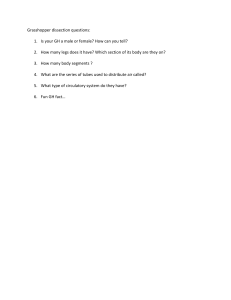
An American National Standard Designation: A 269 – 02 Standard Specification for Seamless and Welded Austenitic Stainless Steel Tubing for General Service1 This standard is issued under the fixed designation A 269; the number immediately following the designation indicates the year of original adoption or, in the case of revision, the year of last revision. A number in parentheses indicates the year of last reapproval. A superscript epsilon (e) indicates an editorial change since the last revision or reapproval. This standard has been approved for use by agencies of the Department of Defense. 1. Scope * 1.1 This specification covers grades of nominal-wallthickness, stainless steel tubing for general corrosion-resisting and low- or high-temperature service, as designated in Table 1. 1.2 The tubing sizes and thicknesses usually furnished to this specification are 1⁄4 in. (6.4 mm) in inside diameter and larger and 0.020 in. (0.51 mm) in nominal wall-thickness and heavier. 1.3 Mechanical property requirements do not apply to tubing smaller than 1⁄8 in. (3.2 mm) in inside diameter or 0.015 in. (0.38 mm) in thickness. A 370 Test Methods and Definitions for Mechanical Testing of Steel Products2 A 1016/A 1016M Specification for General Requirements for Ferritic Alloy Steel, Austenitic Alloy Steel, and Stainless Steel Tubes3 A 480/A 480M Specification for General Requirements for Flat-Rolled Stainless and Heat-Resisting Steel Plate, Sheet, and Strip2 A 632 Specification for Seamless and Welded Austenitic Stainless Steel Tubing (Small-Diameter) for General Service3 E 527 Practice for Numbering Metals and Alloys (UNS)3 2.2 ANSI Standard: B31.3 Chemical Plant and Petroleum Refinery Piping4 2.3 ASME Pressure Vessel Code: Section VIII Division 1, Pressure Vessels5 2.4 Other Standard: SAE J1086 Practice for Numbering Metals and Alloys (UNS)6 NOTE 1—When the impact test criterion for a low-temperature service would be 15 ft·lbf (20 J) energy absorption or 15 mils lateral expansion, some of the austenitic stainless steel grades covered by this specification are accepted by certain pressure vessel or piping codes without the necessity of making the actual test. For example, Grades 304, 304L, and 347 are accepted by the ASME Pressure Vessel Code, Section VIII Division 1, and by ANSI B31.3, for service at temperatures as low as −425°F (−254°C) without qualification by impact tests. Other AISI stainless steel grades are usually accepted for service temperatures as low as −325°F (−198°C) without impact testing. Impact testing may, under certain circumstances, be required. For example, materials with chromium or nickel content outside the AISI ranges, and for material with carbon content exceeding 0.10 %, are required to be impact tested under the rules of ASME Section VIII Division 1 when services temperatures are lower than −50°F (−46°C). 3. Ordering Information 3.1 Orders for material under this specification should include the following, as required, to describe the desired material adequately: 3.1.1 Quantity (feet, metres, or number of lengths), 3.1.2 Name of material (seamless or welded tubes), 3.1.3 Grade (Table 1), 3.1.4 Size (outside diameter and nominal wall thickness), 3.1.5 Length (specific or random), 3.1.6 Optional requirements (heat treatment, see Section 6; hydrostatic or nondestructive electric test, see Section 10), 3.1.7 Test report required (see Section on Inspection of Specification A 1016/A 1016M), 3.1.8 Specification designation, and 1.4 Optional supplementary requirements are provided and, when one or more of these are desired, each shall be so stated in the order. 1.5 The values stated in inch-pound units are to be regarded as the standard. 2. Referenced Documents 2.1 ASTM Standards: A 262 Practices for Detecting Susceptibility to Intergranular Attack in Austenitic Stainless Steels2 3 Annual Book of ASTM Standards, Vol 01.01. Available from American National Standards Institute, 11 West 42nd St., 13th Floor, New York, NY 10036. 5 Available from ASME International, Three Park Avenue, New York, NY 10016-5990. 6 Available from Society of Automotive Engineers, 400 Commonwealth Drive, Warrendale, PA 15096. 1 4 This specification is under the jurisdiction of ASTM Committee A01 on Steel, Stainless Steel and Related Alloys and is the direct responsibility of Subcommittee A01.10 on Stainless and Alloy Steel Tubular Products. Current edition approved Aug. 10, 2002. Published October 2002. Originally published as A 269 – 44 T. Last previous edition A 269 – 01. 2 Annual Book of ASTM Standards, Vol 01.03. *A Summary of Changes section appears at the end of this standard. Copyright © ASTM International, 100 Barr Harbor Drive, PO Box C700, West Conshohocken, PA 19428-2959, United States. 1 TP 304 TP 304L TP 304LN TP 316 TP 316L TP 316LN TP 317 TP 321 TP 347 TP 348 Composition, % TP TP TP TP TP XM-10 XM-11 XM-15 XM-19 XM-29 ... ... ... ... ... ... ... ... ... 0.08 max 2.00 0.030 1.00 0.030 1.00 2 ... ... ... Vanadium Copper Others ... ... ... ... 0.10– 0.16 ... ... ... ... ... ... ... ... ... 10.0– 14.0 16.0– 18.0 2.00– 3.00 ... ... 0.030 1.00 0.045 0.08 max 2.00 ... ... ... ... ... 10.0– 15.0 16.0– 18.0 2.00– 3.00 ... ... 0.030 1.00 0.045 0.035 maxB 2.00 ... ... 0.10– 0.16 ... ... 10.0– 13.0 16.0– 18.0 2.00– 3.00 ... ... 0.030 1.00 0.045 0.035 maxB 2.00 ... ... ... ... ... 11.0– 15.0 18.0– 20.0 3.0– 4.0 ... ... 0.030 1.00 0.045 0.08 max 2.00 ... ... ... ... ... ... ... ... ... ... 10 3 C min 1.10 max ... D ... 9.0– 12.0 17.0– 19.0 ... 0.030 1.00 0.045 0.08 max 2.00 9.0– 12.0 17.0– 19.0 ... 0.030 1.00 0.045 0.08 max 2.00 Co 0.20 max ... ... ... 0.10 E ... 9.0– 12.0 17.0– 19.0 ... 0.030 1.00 0.045 0.08 max 2.00 ... ... 0.15– 0.40 ... ... ... 5.5– 7.5 19.0– 21.5 ... 0.030 1.00 0.08 max 8.00– 10.00 0.045 ... ... 0.15– 0.40 ... ... ... 5.5– 7.5 19.0– 21.5 ... 0.030 1.00 0.04 max 8.00– 10.00 0.045 ... ... ... ... ... ... ... 0.030 1.50– 2.50 17.5– 18.5 17.0– 19.0 ... 0.030 0.08 max 2.00 ... 0.20– 0.40 0.10– 0.30 ... ... 11.5– 13.5 20.5– 23.5 1.50– 3.00 ... 0.10– 0.30 0.030 1.00 0.06 max 4.0– 6.0 0.045 ... ... 0.20– 0.40 ... ... ... ... 2.3– 3.7 17.0– 19.0 ... 0.030 1.00 0.08 max 11.5– 14.5 0.060 0.50– 1.00 ... 0.18– 0.22 ... 17.5– 18.5 19.5– 20.5 6.0– 6.5 ... ... 0.015 0.80 0.030 0.020 max 1.00 ... ... 0.20 max ... ... 13.5– 17.5 18.0– 20.0 4.0– 5.0 ... ... 0.030 1.00 0.045 0.035 max 2.00 ... ... 0.10– 0.20 ... ... 14.5– 17.5 17.0– 20.0 4.0– 5.0 ... ... 0.030 1.00 0.045 0.035 max 2.00 0.50 max ... 14.0– 15.5 17.0– 18.5 0.20 max ... ... 0.020 3.7–4.3 0.020 0.018 max 2.0 ... ... 0.40– 0.60 ... 16.0– 18.0 23.0– 25.0 4.0– 5.0 ... 0.10 max 0.010 1.00 0.030 max 5.0– 7.0 0.030 0.30– 0.60 ... 0.45– 0.55 ... ... 21.0– 23.0 24.0– 25.0 7.0– 8.0 ... ... 0.005 0.50 0.020 max 2.0– 4.0 0.030 0.75 max ... 0.18– 0.25 ... ... 23.5– 25.5 20.0– 22.0 6.0– 7.0 ... ... 0.030 1.00 0.040 0.030 max 2.00 0.50– 1.50 ... 0.15– 0.25 ... ... 24.0– 26.0 19.0– 21.0 6.0– 7.0 ... ... 0.010 0.50 0.030 0.020 max 2.00 1.00– 2.00 ... 0.10 max ... ... 19.0– 23.0 23.0– 28.0 4.0– 5.0 ... ... 0.030 1.00 0.040 0.020 max 2.00 B New designation established in accordance with Practice E 527 and SAE J1086. For small diameter or thin walls, or both, where many drawing passes are required, a carbon maximum of 0.040 % is necessary in grades TP 304L, TP 304LN, 316L and 316LN. Small outside diameter tubes are defined as those with less than 0.500 in. [12.7 mm] in outside diameter and light walls are those less than 0.049 in. [1.2 mm] in minimum wall thickness. C Maximum, unless otherwise indicated. D Grade TP 321 shall have a titanium content of not less than five times the sum of the carbon and nitrogen content and not more than 0.70 %. E Grade TP 348 shall have a columbium plus tantalum content of not less than ten times the carbon content and not more than 1.10 %. F The method of analysis for nitrogen shall be a matter of agreement between the purchaser and manufacturer. A ... ... ... ... ... Tantalum, max NitrogenF ... ... ... ... 8.0– 11.0 18.0– 20.0 ... 0.045 0.045 8.0– 12.0 18.0– 20.0 ... 0.035 maxB 2.00 0.035 maxB 2.00 Titanium Columbium 8.0– 11.0 Chromium 18.0– 20.0 Molybdenum . . . Nickel Manganese, maxC Phosphorus, 0.045 max. Sulfur, max. 0.030 1.00 SiliconC Carbon UNS S30400 S30403 S30453 S31600 31603 S31653 S31700 S32100 S34700 S34800 S21900 S21904 S38100 S20910 S24000 S31254 S31725 S31726 S30600A S24565 S32654 N08367 N08926 N08904 DesignationA Grade TABLE 1 Chemical Requirements % A 269 – 02 A 269 – 02 3.1.9 Special requirements and any supplementary requirements selected. 8. Product Analysis 8.1 An analysis of either one billet or one length of flat-rolled stock or one tube shall be made from each heat. The chemical composition thus determined shall conform to the requirements specified. 8.2 A product analysis tolerance of Table number A1.1 in Specification A 480/A 480M shall apply. The product analysis tolerance is not applicable to the carbon content for material with a specified maximum carbon of .04 % or less. 8.3 If the original test for product analysis fails, retests of two additional billets, lengths of flat-rolled stock, or tubes shall be made. Both retests for the elements in question shall meet the requirements of the specification; otherwise all remaining material in the heat or lot shall be rejected or, at the option of the producer, each billet, length of flat-rolled stock, or tube may be individually tested for acceptance. Billets, lengths of flat-rolled stock, or tubes which do not meet the requirements of the specification shall be rejected. 4. General Requirements 4.1 Material furnished under this specification shall conform to the applicable requirements of the current edition of Specification A 1016/A 1016M, unless otherwise provided herein. 5. Manufacture 5.1 The tubes shall be made by the seamless or welded process. 5.2 At the manufacturer’s option, tubing may be furnished either hot finished or cold finished. 6. Heat Treatment 6.1 All material shall be furnished in the heat-treated condition. Except as provided in 6.2, the heat-treatment procedure shall, except for S31254 and S32654 (see 6.3), S24565 (see 6.4), N08367 (see 6.8), N08904 (see 6.5) and N08926 (see 6.7), consist of heating the material to a minimum temperature of 1900°F (1040°C) and quenching in water or rapidly cooling by other means. Alternatively, for seamless tubes, immediately following hot forming while the temperature of the tubes is not less than the specified minimum solution treatment temperature, tubes may be individually quenched in water or rapidly cooled by other means. 6.2 Controlled structural or special service characteristics shall be specified as a guide for the most suitable heat treatment. If the final heat treatment is at a temperature under 1900°F and is so specified on the order, each tube shall be stenciled with the final heat treatment temperature in degrees Fahrenheit after the suffix “HT”. 6.3 S31254 and S32654 shall be heat-treated to a minimum temperature of 2100°F (1150°C) followed by quenching in water or rapidly cooling by other means. 6.4 S24565 shall be heat-treated in the range 2050°F (1120°C) to 2140°F (1170°C) followed by quenching in water or rapidly cooling by other means. 6.5 N08904 shall be heat treated to a minimum temperature of 2000°F (1100°C) followed by quenching in water or rapidly cooling by other means. 6.6 A solution annealing temperature above 1950°F (1065°C) may impair the resistance to intergranular corrosion after subsequent exposure to sensitizing conditions in TP321, TP347, and TP348. When specified by the purchaser, a lower temperature stabilization or re-solution anneal shall be used subsequent to the initial high temperature solution anneal (see Supplementary Requirement S3). 6.7 N08926 shall be heat-treated to a minimum temperature of 2010°F (1100°C) followed by quenching in water or rapidly cooling by other means. 6.8 UNS N08367 should be solution annealed from 2025°F (1107°C) minimum followed by rapid quenching. 9. Mechanical Tests Required 9.1 Flaring Test (Seamless Tubes)— One test shall be made on specimens from one end of one tube from each lot (Note 2) of finished tubes. NOTE 2—The term lot applies to all tubes prior to cutting to length of the same nominal size and wall thickness which are produced from the same heat of steel. When final heat treatment is in a batch-type furnace, a heat-treatment lot shall include only those tubes of the same size and from the same heat which are heat treated in the same furnace charge. When the final heat treatment is in a continuous furnace or when the heat-treated condition is obtained directly by quenching after hot forming, the number of tubes of the same size and from the same heat in a heat-treatment lot shall be determined from the size of the tubes as prescribed in Table 2. 9.2 Flange Test (Welded Tubes)—One test shall be made on specimens from one end of one tube from each lot (Note 2) of finished tubes. 9.3 Hardness Test—Brinell or Rockwell hardness determination shall be made on specimens from two tubes from each lot. The term lot applies to all tubes prior to cutting, of the same nominal diameter and wall thickness that are produced from the same heat of steel. When final heat treatment is in a batch-type furnace, a lot shall include only those tubes of the same size and the same heat which are heat treated in the same furnace charge. When the final heat treatment is in a continuous furnace or when the heat-treated condition is obtained directly by quenching after hot forming, a lot shall include all tubes of the same size and heat, heat treated in the same furnace at the TABLE 2 Number of Tubes in a Lot Heat Treated by the Continuous Process or by Direct Quench After Hot Forming Size of Tube 2 in. and over in outside diameter and 0.200 in. (5.08 mm) and over in wall thickness Less than 2 in. but over 1 in. in outside diameter or over 1 in. in outside diameter and under 0.200 in. (5.08 mm) in wall thickness 1 in. or less in outside diameter 7. Chemical Composition 7.1 The steel shall conform to the requirements as to chemical composition as prescribed in Table 1. 3 Size of Lot not more than 50 tubes not more than 75 tubes not more than 125 tubes A 269 – 02 TABLE 3 Permissible Variations in Dimensions Group Size, Outside Diameter, in. 1 2 3 4 5 6 7 Up to 1⁄2 1⁄2 to 11⁄2, excl 11⁄2 to 31⁄2, excl 31⁄2 to 51⁄2, excl 51⁄2to 8, excl 8 to 12, excl 12 to 14, excl Permissible Variations in Outside Diameter, in. (mm) 60.005 60.005 60.010 60.015 60.030 60.040 60.050 (0.13) (0.13) (0.25) (0.38) (0.76) (1.01) (1.26) Permissible Variations in Wall Thickness,A % 615 610 610 610 610 610 610 Permissible Variations in Cut Length, in. (mm)B Over ⁄ (3.2) 1⁄8 (3.2) 3⁄16(4.8) 3⁄16(4.8) 3⁄16(4.8) 3⁄16(4.8) 3⁄16(4.8) 18 Thin Walled TubesC Under 0 0 0 0 0 0 0 less less less less less less than than than than than than 0.065 0.095 0.150 0.150 0.200 0.220 ... in. (1.65 in. (2.41 in. (3.81 in. (3.81 in. (5.08 in. (5.59 mm) mm) mm) mm) mm) mm) nominal nominal nominal nominal nominal nominal A When tubes as ordered require wall thicknesses 3⁄4 in. (19.0 mm) or over, or an inside diameter 60 % or less of the outside diameter, a wider variation in wall thickness is required. On such sizes a variation in wall thickness of 12.5 % over or under will be permitted. For tubes less than 1⁄2 in. (12.7 mm) in inside diameter which cannot be successfully drawn over a mandrel, the wall thickness may vary 615 % from that specified. B These tolerances apply to cut lengths up to and including 24 ft (7.3 m). For lengths greater than 24 ft (7.3 m), the above over tolerances shall be increased by 1⁄8 in. (3 mm) for each 10 ft (3 m) or fraction thereof over 24 ft, or 1⁄2 in. (13 mm), whichever is lesser. C Ovality provisions of 11.2 apply. grades shall not exceed 74 on the 30 T scale or 88 on the 15 T scale. 11.3 The hardness test shall not be required on tubes smaller than 1⁄4 in. (6.4 mm) in inside diameter or tubes having a wall thickness thinner than 0.020 in. (0.51 mm) (see A2.4 of Methods and Definitions A 370). Smaller or thinner tubes should be tension tested only, in accordance with Specification A 632. same temperature, time at heat, and furnace speed, or all tubes of the same size and heat, hot formed and quenched in the same production run. 9.4 When more than one heat is involved, the flaring, flanging, and hardness test requirements shall apply to each heat. 9.5 Reverse Flattening Test—For welded tubes, one reverse flattening test shall be made on a specimen from each 1500 ft (460 m) of finished tubing. Coiled tubing greater than 1500 ft (450 m) in length shall be sampled at both ends. A coil must be continuous without any circumferential butt welds. 12. Permissible Variations in Dimensions 12.1 Variations in outside diameter, wall thickness, and length, from those specified, shall not exceed the amounts prescribed in Table 3. 12.2 The permissible variations in outside diameter given in Table 3 are not sufficient to provide for ovality in thin-walled tubes, as defined in the Table. In such tubes, the maximum and minimum diameters at any cross section shall deviate from the nominal diameter by no more than twice the permissible variation in outside diameter given in Table 3; however, the mean diameter at that cross section must still be within the given permissible variation. 10. Hydrostatic or Nondestructive Electric Test 10.1 Each tube shall be subjected to the nondestructive electric test or the hydrostatic test. The type of test to be used shall be at the option of the manufacturer, unless otherwise specified in the purchase order. 11. Hardness Requirements 11.1 Grades TPXM-29, S24565, N08367, and N08926 tubes shall have a hardness number not exceeding 256 HB/270 HV or 100 HRB. Grades TPXM-10, TPXM-11, and TPXM-19 tubes shall have a hardness number not exceeding 269 HB/285 HV or 25 HRC. S31254 shall have a hardness number not exceeding 220 HB/230 HV or 96 HRB. S32654 shall have a hardness number not exceeding 250 HB/263 HV or 100 HRB. Tubes made from all other grades shall have a hardness number not exceeding 192 HB/200 HV or 90 HRB. 11.2 For tubing less than 0.065 in. (1.65 mm) in wall thickness, it is permissible to use the Rockwell superficial hardness test or the Vickers hardness test. When the Vickers test is used, the values of 11.1 will apply. The superficial hardness number for Grade TPXM-29 tubes shall not exceed 80 on the 30 T scale or 92 on the 15 T scale. The hardness number for Grades TPXM-10, TPXM-11, and TPXM-19 tubes shall not exceed 46 on the 30 N scale or 73 on the 15 N scale. The hardness number for S31254 shall not exceed 79 on the 30 T scale or 91 on the 15 T scale. Tubes made from all other 13. Surface Condition 13.1 The tubes shall be pickled free of scale. When bright annealing is used, pickling is not necessary. 14. Product Marking 14.1 In addition to the marking prescribed in Specification A 1016/A 1016M, the marking shall include whether the tubing is seamless or welded and the final heat-treatment temperature in degrees Fahrenheit after the suffix “HT” if the final heat treatment temperature is under 1900°F (1040°C). 14.2 When the Nondestructive Electric Test is performed, each length of tubing shall be marked with the letters “NDE,” and the certification, when required, shall also indicate this test. 15. Keywords 15.1 austenitic stainless steel; seamless steel tube; stainless steel tube; steel tube; welded steel tube 4 A 269 – 02 SUPPLEMENTARY REQUIREMENTS The following supplementary requirements shall apply only when specified by the purchaser in the inquiry, contract, or order. 6, Grades TP321, TP347, and TP348 shall be given a stabilization heat treatment at a temperature lower than that used for the initial solution annealing heat treatment. The temperature of stabilization heat treatment shall be at a temperature as agreed upon between the purchaser and vendor. S1. Stress-Relieved Annealed Tubes S1.1 For use in certain corrosives, particularly chlorides where stress corrosion may occur, tubes in Grades TP304L, TP316L, TP321, TP347, and TP348 may be specified in the stress-relieved-annealed condition. S1.2 When stress-relieved tubes are specified, tubes shall be given a heat treatment at 1550 to 1650°F (845 to 900°C) after roll straightening. Cooling from this temperature range may be either in air or by slow cooling. No mechanical straightening is permitted after the stress-relief treatment. S1.3 Straightness of the tubes and additional details of this supplementary requirement shall be agreed upon between the manufacturer and purchaser. S4. Intergranular Corrosion Test S4.1 When specified, material shall pass intergranular corrosion tests conducted by the manufacturer in accordance with Practices A 262, Practice E. S4.2 A stabilization heat treatment in accordance with Supplementary Requirement S3 may be necessary and is permitted in order to meet this requirement for the grades containing titanium or columbium. S2. Air Underwater Pressure Test S2.1 When specified, the tubing shall be examined by the air underwater pressure test. NOTE S4.1—Practice E requires testing on the sensitized condition for low carbon or stabilized grades, and on the as-shipped condition for other grades. S3. Stabilizing Heat Treatment S3.1 Subsequent to the solution anneal required in Section SUMMARY OF CHANGES This section identifies the location of changes to this specification that have been incorporated since the last issue, A 269 – 01. (1) Specification A 450/A 450M has been changed to Specification A 1016/A 1016M. (2) Changed Nickel content for UNS S31603 from 10.0–14.0 to 10.0–15.0 in Table 1. ASTM International takes no position respecting the validity of any patent rights asserted in connection with any item mentioned in this standard. Users of this standard are expressly advised that determination of the validity of any such patent rights, and the risk of infringement of such rights, are entirely their own responsibility. This standard is subject to revision at any time by the responsible technical committee and must be reviewed every five years and if not revised, either reapproved or withdrawn. Your comments are invited either for revision of this standard or for additional standards and should be addressed to ASTM International Headquarters. Your comments will receive careful consideration at a meeting of the responsible technical committee, which you may attend. If you feel that your comments have not received a fair hearing you should make your views known to the ASTM Committee on Standards, at the address shown below. This standard is copyrighted by ASTM International, 100 Barr Harbor Drive, PO Box C700, West Conshohocken, PA 19428-2959, United States. Individual reprints (single or multiple copies) of this standard may be obtained by contacting ASTM at the above address or at 610-832-9585 (phone), 610-832-9555 (fax), or service@astm.org (e-mail); or through the ASTM website (www.astm.org). 5





